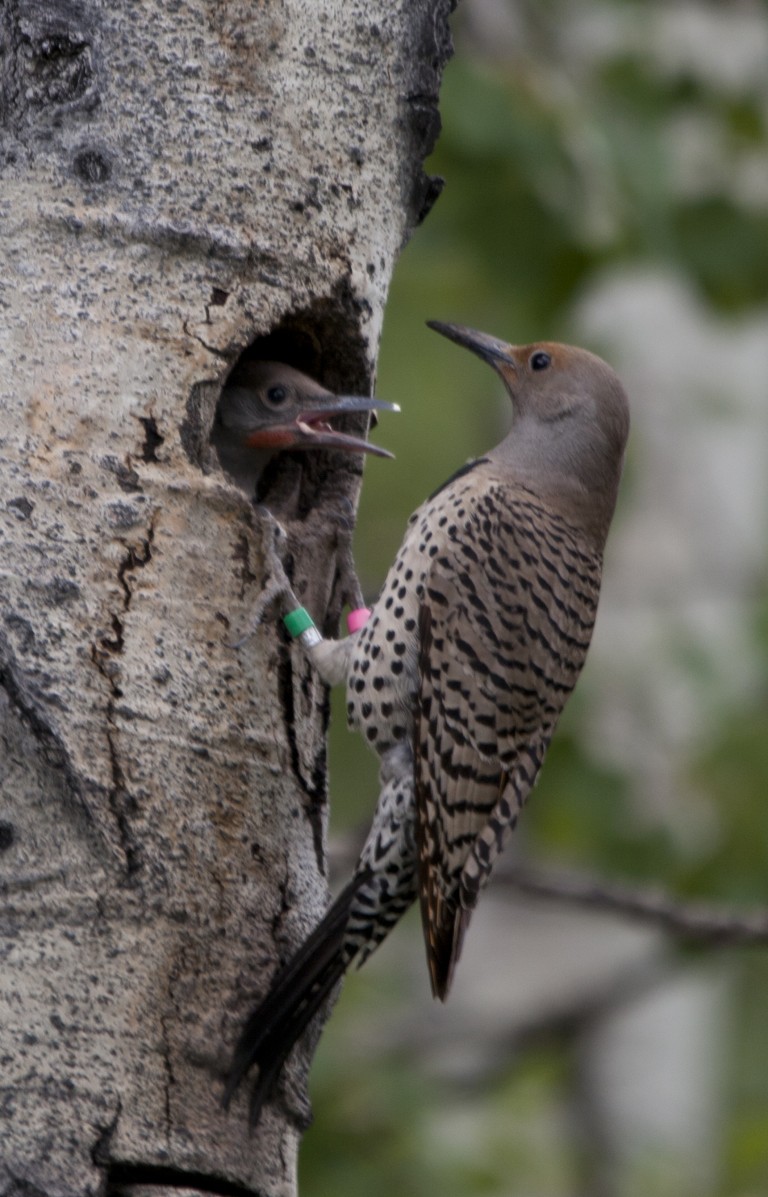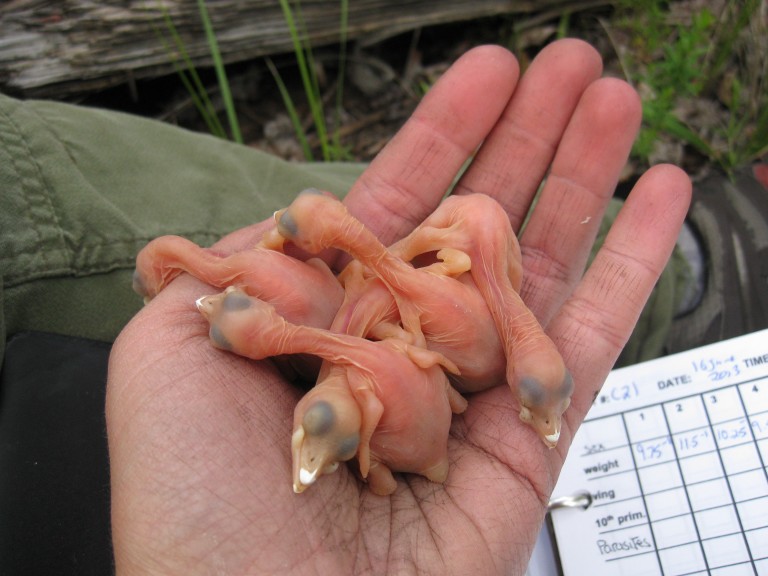Have you ever wondered about the sex lives of birds? You know, the birds and the bees, as the saying goes. It sounds so simple, but avian mating systems are incredibly complex. In fact, most known types of mating systems occur in birds. What is a mating system you may ask? A mating system is how social groups are structured in relation to sexual behaviour. We as humans can think of a family with a father and mother and kids as a socially monogamous mating system. Monogamous means only one partner at a time. Monogamy is actually rare across the animal kingdom, but it is the most common type of mating system in birds, or is it?

Female at cavity. A female northern flicker feeds her young at the cavity. Old flicker nestlings climb up the inside of the cavity to the cavity entrance to be fed by the parents. Photo by Elizabeth Gow.
Most birds are socially monogamous, meaning a male and female work together to raise their kids (nestlings or chicks). However, some young in the nest may not be genetically related to the male who is providing the parental care. This is in fact very common in birds. Both males and females will actively seek what we refer to as ‘extra-pair’ mates, where they will go around and essentially ‘cheat’ on their social mate by copulating with one of their neighbours!
In some species, such as superb fairy wrens (Malurus cyaneus) most offspring in a nest come from outside the monogamous pair bond (76%) and almost all nests (95%) had at least one extra-pair young (Mulder et al. 1994). Fairy wren males expect most of the young in the nest will belong to other males and so they provide little if any parental care (Mulder et al. 1994). In contrast, a species like northern flickers has almost zero extra-pair mating (Wiebe and Kempenaers 2009), and males provide far more parental care than females by spending more time caring for fledglings (young when they leave the nest; Gow and Wiebe 2014).

Flicker nestlings Flicker nestlings are blind when they are young. These nestlings are only 5 days old and both the mother and father will enter the cavity and use the little white ‘egg tooth’ on the tip of their bill to guide the parent to their mouths to feed them. Photo by Elizabeth Gow.
So why would this extra-pair mating happen? From the male’s perspective it is easy to see that he can increase the number of young he is genetically related to by engaging in lots of copulations with multiple partners. So males can increase the chances of their genes being passed on to future generations via extra-pair mating. Countless studies have shown it is the sexiest males (e.g. the ones with best plumage, song, or dance moves) that usually have the highest number of extra-pair young. In this way, the good genes from the best males are most likely to be passed on. But what about the females, do they have any benefits to engaging in promiscuous behaviour? Although, there are several hypotheses suggesting why females engage in extra-pair mating, such as potentially improving her offspring’s fitness by mating with a ‘good’ male, or assuring that even if her social mate is infertile she will still produce offspring, the specific evolutionary advantage to females is up for debate and is a topic of a lot of current research.
So the next time you see young birds being fed by their ‘dad’, will you be thinking: “Is he really your daddy?”.
Literature Cited:
Gow, E.A., and Wiebe, K.L. 2014. Determinants of parental care and offspring survival during the post-fledging period: males care more in a species with partially reversed sex roles. Oecologia. 175:95–104.
Mulder, R.A., Dunn, P.O., Cockburn, A., Lazenby-Cohen, K.A., and Howell, M.J. 1994. Helpers liberate female fairy-wrens from constraints on extra-pair mate choice. Proceedings of the Royal Society B. 255:223–229.
Wiebe, K.L., and Kempenaers, B. 2009. The social and genetic mating system in flickers linked to partially reversed sex roles. Behavioral Ecology. 20:453–458.
